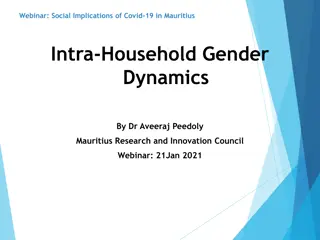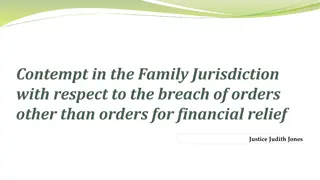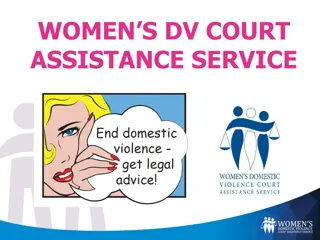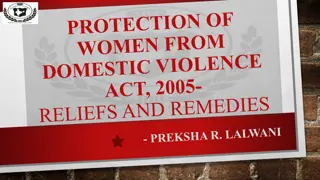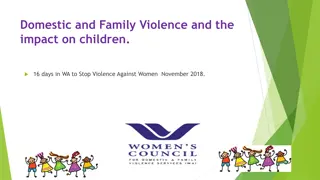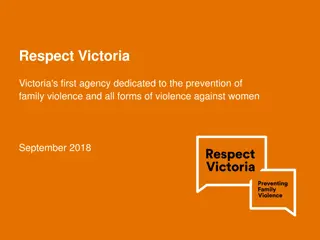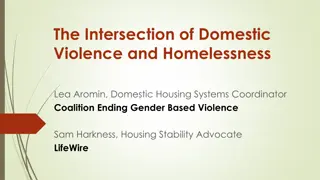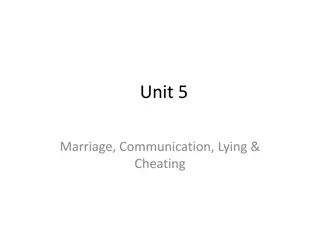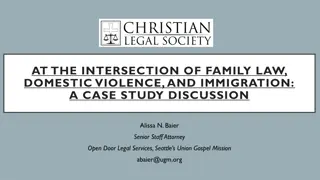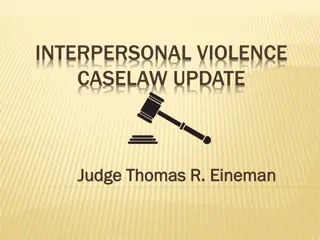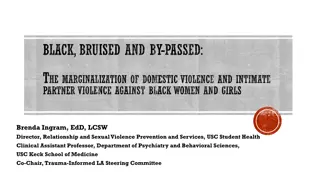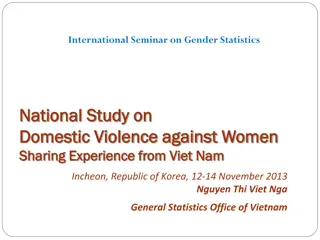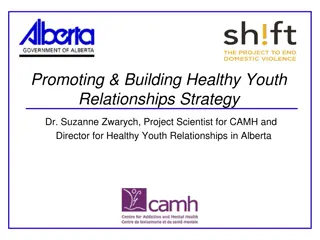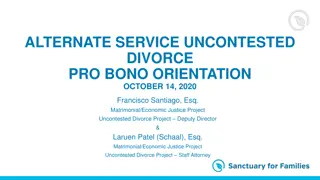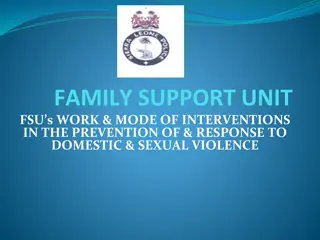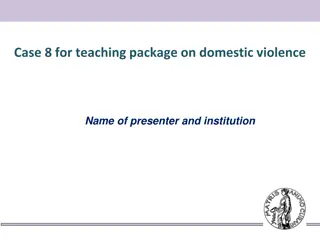Non-Molestation Orders and Domestic Violence under Family Law
Family Law Training session covers Non-molestation orders, Occupation orders, and Interviewing Domestic Violence victims under the Family Law Act 1996. It elaborates on the granting of non-molestation orders, associated persons, molestation definition, and the impact of molestation on health and well-being. The session highlights the importance of protecting individuals from domestic abuse and the legal interventions available.
Download Presentation

Please find below an Image/Link to download the presentation.
The content on the website is provided AS IS for your information and personal use only. It may not be sold, licensed, or shared on other websites without obtaining consent from the author. Download presentation by click this link. If you encounter any issues during the download, it is possible that the publisher has removed the file from their server.
E N D
Presentation Transcript
Family Law Training Lisa Okoroafor Legal Advice Centre (University House) October 2021
This session will cover: Non-molestation orders Occupation orders Interviewing Domestic Violence victims
Introduction Under Family Law Act 1996 (FLA 1996), an individual can apply for an injunction if they have been a victim of domestic abuse. An individual can apply for: A non-molestation order which protects the applicant and/or their child from being molested, harmed or threatened by the person who has abused them An occupation order which confers, declares, restricts or regulate rights of occupation in the family home between parties who are in, or who have been in, certain categories of relationship
Non Molestation Order
When can a non-molestation order be granted? Under Family Law Act (FLA 1996) S42(2)(a) a non molestation order can only be granted to protect a person associated with the respondent or a relevant child. A person is associated with another person if: they are or have been married they are or have been civil partners they are cohabitants or former cohabitants they live or have lived in the same household otherwise than merely by reason of one being the other s employee, tenant, lodger or boarder this could include, for example, students. they are relatives they have agreed to marry one another they have entered into a civil partnership agreement, they have or have had an intimate personal relationship with each other that is or was of significant duration in relation to any child they are both either a parent or have parental responsibility for the child they are parties to the same family proceedings
Molestation There is no statutory definition of the term molestation. Therefore, guidance can be elicited from the case law. The leading case is Vaughan v Vaughan[1973] 3 All ER 449 where the court equated molestation with pestering . In C v C (Non-Molestation Order: Jurisdiction) [1998] 1 FLR 554 Sir Stephen Brown stated: 'there is no legal definition of 'molestation'. Indeed, that is quite clear from the various cases which have been cited. It is a matter which has to be considered in relation to the particular facts of particular cases. It implies some quite deliberate conduct which is aimed at a high degree of harassment of the other party, so as to justify the intervention of the court . Molestation involves any form of physical, sexual or psychological molestation or harassment that has a serious impact on the health and well-being of the applicant. Violence is not a prerequisite. In the autumn of 2013 the government agreed a new definition of domestic violence and abuse that is to be used by all government departments. In the guidance, domestic violence and abuse is defined as any incident or pattern of incidents of controlling, coercive or threatening behaviour, violence, or abuse between those aged 16 or over who are, or have been, intimate partners or family members regardless of gender or sexuality. The abuse can encompass, but is not limited to, that which is: Psychological Physical Sexual Financial Emotional
The terms of a Non-Molestation Order From and after the time when the Respondent is made aware of the terms of this order whether by personal service or telephone or text message or social media or otherwise the Respondent whether by himself or acting jointly with any other person is forbidden to: Use or threaten violence against the Applicant; Threaten, intimidate, harass, verbally abuse or pester the Applicant in any way; Communicate with the Applicant, or anyone associated with him/her, whether by letter, telephone, text message, social media or other means of communication; Send any threatening or abusive letters, emails, text or voicemail messages to the Applicant or anyone associated with him/her; The Respondent must not damage, attempt to damage or threaten to damage any property (including any contents within any property) owned by or in possession or control of the Applicant; The respondent is also forbidden to instruct, encourage or in any way suggest that any other person to do anything which he is forbidden to do by the terms of this Order. This order shall remain in force until 4:00pm on the order of the court. unless before then it is varied or discharged by an
The terms of a Non-Molestation Order (2) Exclusion zones When making a non-molestation order the court can include a stay away clause providing for an exclusion zone. The order may provide eg that one part must not go within 100 meters of where the party lives. Such a provision in a non-molestation order must be proportionate and necessary and supported by evidence and should not be routinely included in such orders. In R v R (Family Court: Procedural Fairness)[2014] EWFC 48 - the court held that extra injunctive provisions such as exclusion areas and orders prohibiting any direct communication between parties should not be routinely included in non-molestation orders. They are serious infringements of a person's freedom of action and require specific evidence to justify them. An order that requires a party to leave a property cannot form part of a non-molestation order and can only be made as part of an occupation order. If the court is considering applications for both a non-molestation order and an occupation order and makes both types of order the orders must each be drawn up separately.
How does the court decide whether to make a Non-Molestation Order? The court has a wide discretion whether to grant or refuse the relief sought. FLA 1996 S42(5) states that in deciding whether to make an order the court needs to consider all of the circumstances of the case including the health, safety and well-being of the applicant and any child or children. The court in C v C (Non-Molestation Order: Jurisdiction) established three principles that should be considered by the court when considering whether to grant the order: there must be evidence of molestation going on the applicant or child must need protection the judge must be satisfied that judicial intervention is required to control the respondent s behaviour Health includes physical and mental health. There is no definition regarding safety or well-being.
How long do Non-Molestation Orders last? Non molestation orders normally last for a specific period of time often 6 months or a year. An Order made on a without notice application may be limited up to the date of the return hearing (usually within 7-14 days ) by which time the respondent will have been served with the without notice order. The respondent will be aware of the terms of the order and invited to attend the return hearing. When a final order is made it can be for an indefinite period but this is rare.
What are the consequences of breaching a Non-Molestation Order? A breach of a non-molestation order is a criminal offence so if the respondent breaches one or more of the terms, the respondent can be arrested and brought before a criminal court. The respondent could be remanded in custody depending upon the seriousness of the breach. If this happens the applicant will be treated as a witness and will not have their own legal representation in the criminal court; the police and the Crown Prosecution Service (CPS) will pursue the prosecution against the respondent. A person found guilty of an offence of breaching a non-molestation order can be liable: on conviction on indictment, to imprisonment for a term not exceeding five years, or a fine, or both; on summary conviction, to imprisonment for a term not exceeding 12 months, or a fine not exceeding the statutory maximum, or both.
Application process The application form FL401 should accompany a comprehensive statement explaining why there is a genuine need for a protective injunction. The court will consider the evidence provided by the applicant and will decide whether an order is necessary and, if so, the terms of the order to ensure that the health, safety and welfare of the applicant (and any child) are maintained. A statement should begin with brief background, it should convey an accurate timeline of events, including the first, the worst and the most recent incidents of domestic abuse. There is no Court fee for non-molestation order applications. An application can be made with or without notice. FLA 1996 s45 is to be considered if a without notice application is to be made. A draft order should be lodged when the application is issued. Download and fill in form C8 if the applicant wants to keep their address private. Email or send all the documents to the applicant s local court that deals with domestic abuse cases.
Court Hearings Without notice hearing (if an application has been made without notice) Return Hearing or On notice hearing (if an application has been made on notice) Final Hearing
An occupation order is an order made under the section 33-38 FLA 1996 If a couple cannot agree what to do with a property following a relationship breakdown, they will have to apply to the court to resolve the situation. In the short term, the court can make an occupation order under the FLA1996 setting out, for example, who can live at the property or ordering one of the spouses or civil partners to leave. Occupation orders are only a short-term solution and will not affect what happens to the property in the final financial remedy settlement. Occupation orders can only be made in relation to a dwelling-house. A dwelling-house for this purpose includes: any building or part of a building which is occupied as a dwelling any caravan, houseboat or structure which is occupied as a dwelling, and any yard, garden, garage or outhouse belonging to the above and occupied with it
Categories of application Occupation orders can be made under five different sections of FLA 1996 detailing distinct sets of circumstances. The extent of the court s powers depends on the eligibility of the applicant, their relationship with the respondent and the status of the dwelling-house. It is therefore important that the application and order is made under the correct section of FLA 1996. As a first step the category that the applicant falls into should be ascertained so as to establish the type of order that may be made and the criteria that will be applied. Note that if an application is made under the incorrect section, the court has the power to remedy the defect The categories of applicant are: applicant has an estate, interest or home rights in the dwelling-house (Section 33) applicant is a former spouse or former civil partner with no existing right to occupy (Section 35) applicant is a cohabitant or former cohabitant with no existing right to occupy (Section 36) where neither spouse or civil partner are entitled to occupy (Section 37) where neither cohabitant or former cohabitant are entitled to occupy (Section 38)
Categories of application (2) The Marriage (Same Sex Couples) Act 2013 - provides that, with effect from 13 March 2014, where there are references to a marriage, a married couple or a married person in existing legislation in England and Wales, these are to be read as also referring to a marriage of a same-sex couple, a married same-sex couple or to a person married to someone of the same sex.
Applicant who has an estate, interest or home rights in a dwelling-house Section 33 Is the widest in scope of the sections The applicant is entitled to occupy a property termed a dwelling-house The respondent is associated The house must be, have been, or have been intended to be, the home of the applicant and respondent The court must consider the balance of harm test in Section 33(7) FLA 1996 before considering the discretionary criteria in Section 33(6) FLA 1996
Balance of Harm Test and Discretionary Criteria Balance of harm test If it appears to the court that the applicant or any relevant child is likely to suffer significant harm attributable to the conduct of the respondent if an order is not made, it is mandatory for the court to make an occupation order unless it appears that the respondent or any relevant child is likely to suffer significant harm if the order is made and that harm is as great or greater than the harm likely to be suffered by the applicant. This is known as the balance of harm test. Discretionary criteria If the court determines that neither the applicant or relevant child is likely to suffer significant harm attributable to the conduct of the respondent, it enters the discretionary regime. The criteria to be applied in deciding whether to exercise its powers are all the circumstances including: the housing needs and housing resources of each of the parties and of any relevant child the financial resources of each of the parties the likely effect of any order, or decision not to exercise powers, on the health, safety or well-being of the parties and any relevant child the conduct of the parties
Orders available under Section 33 FLA 1996 The court may make orders that: enforce the applicant s entitlement to remain in occupation as against the respondent require the respondent to permit the applicant to enter and remain in the dwelling-house or part of the dwelling-house regulate the occupation of the dwelling-house by either or both parties prohibit, suspend or restrict the respondent s right to occupy the dwelling-house restrict or terminate the respondent s home rights in relation to the dwelling-house require the respondent to leave the dwelling-house or part of the dwelling-house exclude the respondent from a defined area in which the dwelling-house is included
Ancillary Orders (Section 40 FLA 1996) Where an occupation order is made under FLA 1996 s33, s35 or s36, the court has the power to impose obligations on either party. These obligations include payments towards the rent, mortgage or other outgoings, repair and maintenance. Furthermore, the court can grant either party possession or use of furniture or contents of the dwelling-house and order either party to take reasonable care of furniture. The additional provisions cannot last longer than the occupation order itself. The court shall have regard to all the circumstances of the case including: the financial needs and other resources of the parties the financial obligations that they have or are likely to have in the foreseeable future, including obligations to each other and to any relevant child In Nwogbe v Nwogbe [2000], the Court of Appeal held that an order made under Section 40 FLA 1996 requiring a man to make payments in respect of rent and other outgoings relating to the property could not be enforced. The man had failed to make the required payments and the woman sought to have him committed to prison for contempt.
What are the consequences of breaching an Occupation Order? The process for enforcing the order varies depending on whether a power of arrest is attached to the order. A power of arrest allows police officers to arrest the respondent if the occupation order is breached. Powers of arrest can be attached to occupation orders if the court is satisfied that your abuser has used or threatened violence against you. If your abuser breaches any part of your occupation order and there is a power of arrest attached to it, you can report the breach directly to the police. The police can arrest him and take him to the court that made the order to be punished. The court may hear evidence about the breach and deal with the respondent immediately, or the court may adjourn the hearing to another day. If your occupation order does not have a power of arrest attached, you can still apply to the court that made the order to have your abuser arrested and / or punished, if he has breached any part of the order. A respondent who is found by the court to have breached the order may be committed to prison, fined or be given a suspended sentence of imprisonment. The procedure in relation to applications and proceedings for committal for contempt of court is governed by Family Procedure Rules 2010 part 37 and the accompanying practice direction 37A.
Application process Check if the applicant is eligible to apply for an occupation order. The application form FL401 should accompany a comprehensive statement explaining why there is a genuine need for an occupation order. The court will consider the evidence provided by the applicant and will decide whether an order is necessary. There is no Court fee for occupation order applications. An application can be made with or without notice. FLA 1996 s45 is to be considered if a without notice application is to be made. A draft order should be lodged when the application is issued. Download and fill in form C8 if the applicant wants to keep their address private. Email or send all the documents to the applicant s local court that deals with domestic abuse cases.
Service of application and supporting documents The applicant must arrange for a copy of their application and witness statement to be served on the respondent. The applicant s solicitor will arrange a process server or if the applicant is acting in person they can ask the court to serve the documents. The applicant should not serve the documents themselves.
Duration of an Occupation Order At the court's discretion, occupation orders can last: Indefinitely For a certain length of time, or Until a specific event occurs, such as a divorce In practice it is unlikely to be for more than 6 months.
Interviewing Domestic Violence victims Sensitivity issues when interviewing Domestic Violence clients
1. Create a reassuring atmosphere which facilitates an open dialogue between client and adviser It is important to understand that victims of abuse may be reluctant to disclose what has happened to them but having a conversation can help them to understand their situation better and build up trust. Domestic abuse victims are likely to feel constantly anxious and afraid and that fear will include talking to others about what is happening. There are many reasons why victims will not or feel they cannot talk about their experiences (e.g. fear, retaliation, denial, minimisation, embarrassment, being judged). Where there are inequalities (e.g. age, disability, ethnicity, sexuality etc.) it can make it harder. It is very important to build up trust to enable and facilitate engagement. Whenever possible, the interview should be conducted in a quiet, private, and safe location.
1. Create a reassuring atmosphere which facilitates an open dialogue between client and adviser (2) The adviser should ensure that any discussions with victims of abuse are conducted in a safe and confidential environment without disruptions. The adviser should be clear with the victim about confidentiality. Reassure the client about confidentiality and explain the limits of this, e.g. I m going to ask you a question and I want you to know that whatever you tell me will go no further without your permission, unless I believe a child or vulnerable person is at risk .
1. Create a reassuring atmosphere which facilitates an open dialogue between client and adviser (3) The victim may be reluctant to discuss their personal issues when an adviser is taking notes during an interview. The client may not understand that the notes are confidential or may not trust the adviser at such an early stage. Thus, the adviser should first establish rapport with the client by introducing herself, explaining that all information is confidential (unless the lawyer has mandatory legal reporting obligations relating to child abuse, in which case this obligation should be disclosed to the client), and begin the interview by making eye contact with the client. If the adviser wishes to take notes, they should explain to the client why they needs to take notes (i.e. to help the client achieve her legal goals) and ask the client for permission to write down information during the interview.
1. Create a reassuring atmosphere which facilitates an open dialogue between client and adviser (4) The adviser should show the client that they have time to listen if the adviser appears rushed or uninterested, the victim will be less likely to engage about incidents. The adviser must make sure they establish how long they have available to talk to the client. It is good practice to state a time frame at the beginning of the interview, so the client is aware. The adviser should try to be the first to speak and say things like " Mrs x, how are you today? how are the children?". If the adviser makes conversation, the client will begin to feel comfortable and this will facilitate an open dialogue between the two parties. The client will not engage in an open dialogue if he/she feels tense about the adviser, the adviser must be polite, sensitive, and kind. The client will give the adviser a more open version of the incidents of the abuse if they feel they are being listened to as this creates a comfortable environment to engage.
2. Begin a conversation about the client's experiences in a sensitive way. A good starting point is for the adviser to explain that they want to help the client but before they can do that, they need more information about the events which have taken place. Begin with an open indirect question, e.g. tell me how things are going ; Are you alright? ; Can you tell me what happened? . Then use framing questions to explain your questioning that places the victim s experiences into context e.g. I want to have a better understanding of the incidents you have been through so I can see how I can help you . When it is time to get into specific incidents, ask open-ended questions. There are several reasons for this.
2. Begin a conversation about the client's experiences in a sensitive way (2) First, it helps to establish trust when you show a willingness to listen. If the client senses that you do not have the time or the interest to hear them out, they will begin to edit the information in ways that may limit your understanding of the incident. Second, people remember best when they tell their story in a narrative form and in context. When you elicit a story by asking direct questions, they respond with just what you asked for and may not provide the important details that you did not ask about. Note also that memories of trauma may be fragmented, out-of-order, or have gaps. Perception of time may also be distorted. This is a normal biological response to traumatic events. When a domestic violence victim is allowed to tell their story uninterrupted, they may begin to sort out the memories in ways that result in a more accurate and complete memory.
2. Begin a conversation about the client's experiences in a sensitive way (3) As you are listening to her/his story, ask only clarifying questions that are essential to your understanding of the story. The ability to truly listen is an important skill that can only be learned by purposeful practice. Become comfortable with silence. When you rush in with another question, you may interrupt her/his thought process and discontinue the additional information. Explain that the client should take their time and if they need to stop, they may do so. This allows the client to feel reassured and at ease. The adviser should try to guide the client a little, to have a better understanding of what has happened. For instance, when did the couple meet, how long before the abuse started and any dates of incidents etc. When the victim is disclosing specific incidents of abuse, the lawyer should not be afraid to ask questions.
2. Begin a conversation about the client's experiences in a sensitive way (4) Advisers should remember that earning the victim s confidence and cooperation may rely on the kinds of questions asked and the way they are asked. The advisers should be aware of their body language. How an adviser stands and holds his or her arms and head, the nature of the adviser s facial expression and the advisers tone of voice all convey a clear message to victims about how the adviser perceives the situation. For example, even though the adviser may be making calming, supportive statements, the adviser s body language can convey the opposite message of boredom, irritation, disbelief, dislike, or anger.
3. Effectively navigate a situation in which the client becomes distressed when recounting a personal experience. When the client becomes distressed, the adviser should advise the client to take a moment and offer some water/tissue. The client will feel mixed emotions as they navigate through their experiences. It is for the adviser to ensure the client feels comfortable to take a short break when overwhelmed. If the client becomes too distressed, it would be a good idea to move onto another incident and return to that specific incident if the client feels comfortable. Many clients feel extremely distressed when talking about being raped. I discourage advisers not to go into detail about these events. The advisers should offer validation statements like "I am glad you have found the strength to leave, no one deserves to be treated this way". This is an effective tool to make the client feel courage and strength and that they have made the right decision in leaving the perpetrator and seeking help.
3. Effectively navigate a situation in which the client becomes distressed when recounting a personal experience (2) After an episode of domestic violence, the victim will often experience feelings that might hinder an interview. This is especially true in cases where there is a history of domestic violence. Feelings that may inhibit the victim s willingness to cooperate include: Fear for self, children and possibly, for perpetrator Immobilization and shock. Feelings of helplessness and hopelessness to effect change Guilt, shame, or embarrassment. Feelings of self-blame, i.e., the victim may feel that they are responsible for the violence. Feelings of isolation, i.e. the victim may have been isolated and appear unresponsive or impaired.
4. Responding to Victim Fears To gain the victim s confidence and cooperation, the adviser must show themselves to be aware of and responsive to her feelings. By reassuring the victim in this way, the adviser will increase her willingness to reveal the specifics of the incidents. To reassure the victim - emphasize that the victim is not responsible or to be blamed for the violence and that they will get the help they need. Advisers may encounter victims who appear extremely reluctant to cooperate with the interview. In addition to issues mentioned above, such as embarrassment, shame, guilt and fear, there are additional elements influencing domestic violence victims response to law enforcement personnel and to the criminal justice system. Some victims are genuinely confused about their feelings toward the offender. Some domestic violence offenders are respected members of their communities. When they are not violent, they may be very good fathers or mothers and loving husbands or wives. Further, family and friends may not believe the victim s stories of violence and may even pressure her/him again and again to give him/her another chance.
Thank you for listening. Lisa Okoroafor Lisa@legaladvicecentre.london
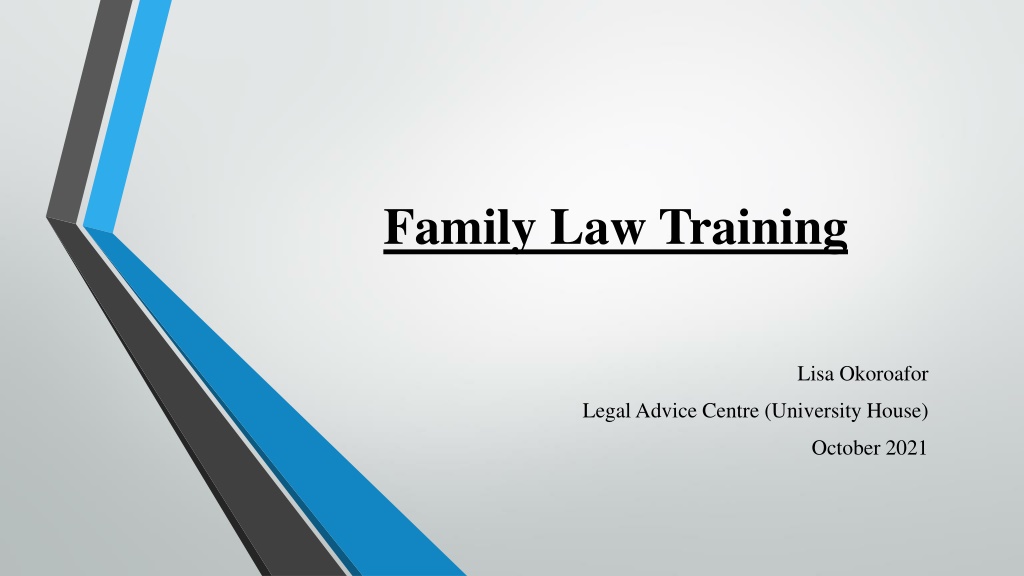
 undefined
undefined



